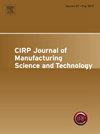Ultra-precision surface treatment of beta-titanium alloy printed using laser and electron beam melting sources
IF 4.6
2区 工程技术
Q2 ENGINEERING, MANUFACTURING
CIRP Journal of Manufacturing Science and Technology
Pub Date : 2025-01-31
DOI:10.1016/j.cirpj.2025.01.006
引用次数: 0
Abstract
Additive Manufacturing (AM) is a near net shape fabrication technology offering exceptional design freedom for complex part production. However, the inadequate surface quality and poorly generated micro-features adversely affect the functional performance of metal AM parts thereby restricting the direct adoption in biomedical implantation applications. Ultra-precision diamond turning (UPDT) can be regarded as a possible solution to overcome the aforementioned challenges in metal AM. However, the machinability of metal AM parts at ultra-precision level is highly sensitive to the material specific attributes and microstructure generated by the thermal characteristics of the process. In light of this, the present study follows a novel direction by investigating the dependence of distinct material characteristics imparted by two different AM powder melting sources on the ultra-precision post-treatment performance. Experiments were conducted on laser and electron beam printed beta-Ti alloy (Ti-15Mo-5Zr-3Al) which has potential importance in biomedical applications. The results demonstrate that the microstructural variations in respective samples affect the process performance and final surface integrity. The samples printed using laser powder bed fusion (LPBF) achieved a final surface finish (Sa) of ∼66.3 nm after UPDT relative to the electron beam powder bed fusion (EPBF) samples (∼104.3 nm). The cutting forces tends to exhibit sharp dip in forces in case of LPBF samples when micro-cutting was done perpendicular to the beam scanning direction. The chip morphology analysis corresponding to the LPBF and EPBF samples substantiates the generation of chips with segmentation/serrations on the free chip surface and parent material adhesion on the tool-chip contact surface. Further, precise microfeature generation was successfully accomplished on both the samples with minimal dimensional deviations on LPBF sample. Thus, the outcomes of the study establish the potential of UPDT in elevating the bioimplant surface standards of beta-Ti alloy with superior performance in LPBF samples.
激光和电子束熔化源打印钛合金的超精密表面处理
增材制造(AM)是一种近净形状制造技术,为复杂零件的生产提供了卓越的设计自由度。然而,金属增材制造零件的表面质量不佳和微特征生成不良会影响其功能性能,从而限制了其在生物医学植入领域的直接应用。超精密金刚石车削(UPDT)可以被视为克服上述金属增材制造挑战的可能解决方案。然而,金属增材制造零件在超精密水平上的可加工性对工艺热特性产生的材料特性和微观结构高度敏感。鉴于此,本研究沿着一个新的方向,研究了两种不同AM粉末熔化源赋予的不同材料特性对超精密后处理性能的依赖关系。对具有潜在生物医学应用价值的β -钛合金(Ti-15Mo-5Zr-3Al)进行了激光和电子束打印实验。结果表明,各试样的显微组织变化影响了工艺性能和最终表面完整性。使用激光粉末床熔融(LPBF)打印的样品在UPDT后的最终表面光洁度(Sa)为~ 66.3 nm,相对于电子束粉末床熔融(EPBF)样品(~ 104.3 nm)。在垂直于光束扫描方向进行微切削时,LPBF样品的切削力有急剧下降的趋势。LPBF和EPBF样品对应的切屑形貌分析证实了自由切屑表面产生的切屑具有切分/锯齿,母材粘附在刀具-切屑接触面。此外,在LPBF样品上以最小的尺寸偏差成功地完成了两种样品的精确微特征生成。因此,研究结果表明,UPDT在提高LPBF样品中具有优越性能的β -钛合金生物植入物表面标准方面具有潜力。
本文章由计算机程序翻译,如有差异,请以英文原文为准。
求助全文
约1分钟内获得全文
求助全文
来源期刊

CIRP Journal of Manufacturing Science and Technology
Engineering-Industrial and Manufacturing Engineering
CiteScore
9.10
自引率
6.20%
发文量
166
审稿时长
63 days
期刊介绍:
The CIRP Journal of Manufacturing Science and Technology (CIRP-JMST) publishes fundamental papers on manufacturing processes, production equipment and automation, product design, manufacturing systems and production organisations up to the level of the production networks, including all the related technical, human and economic factors. Preference is given to contributions describing research results whose feasibility has been demonstrated either in a laboratory or in the industrial praxis. Case studies and review papers on specific issues in manufacturing science and technology are equally encouraged.
 求助内容:
求助内容: 应助结果提醒方式:
应助结果提醒方式:


